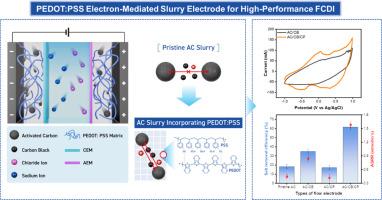当前位置:
X-MOL 学术
›
Water Res.
›
论文详情
Our official English website, www.x-mol.net, welcomes your
feedback! (Note: you will need to create a separate account there.)
Enhanced Salt Removal in Flow-Electrode Capacitive Deionization Using PEDOT:PSS as an Electron Mediator
Water Research ( IF 11.4 ) Pub Date : 2025-05-31 , DOI: 10.1016/j.watres.2025.123940
Nguyen Anh Thu Tran, Tran Minh Khoi, Jingoo Kim, Kimin Chae, Yuna Shin, Wook Ahn, Young-Woo Lee, Huu Thang Nguyen, Thi Ngoc Tram Le, Yun Ho Kim, Seung Woo Lee, Younghyun Cho
Water Research ( IF 11.4 ) Pub Date : 2025-05-31 , DOI: 10.1016/j.watres.2025.123940
Nguyen Anh Thu Tran, Tran Minh Khoi, Jingoo Kim, Kimin Chae, Yuna Shin, Wook Ahn, Young-Woo Lee, Huu Thang Nguyen, Thi Ngoc Tram Le, Yun Ho Kim, Seung Woo Lee, Younghyun Cho

|
Capacitive deionization (CDI) is an energy‐efficient and environment-friendly water desalination technology that removes salt ions via electrosorption on porous electrodes. Specifically, CDI using flowable electrodes (FCDI) enables continuous desalination without needing discharging, due to the continuous flow of suspended activated carbon (AC) particles. However, its salt removal performance is limited by the insufficient interparticle electrical connectivity between AC particles. To overcome this drawback, we introduce poly(3,4-ethylenedioxythiophene):polystyrene sulfonate (PEDOT:PSS), a well-known conducting polymer with excellent electrical conductivity, high stability, and good compatibility with aqueous environments, into the aqueous slurry electrode to form efficient electrical bridges among AC particles. Rather than serving as a primary ion-sorbing material, PEDOT:PSS functions as an electron mediator, enhancing charge transfer and ion electrosorption within the flow electrode. Furthermore, a conductivity-optimized doping strategy was employed to maximize the electron mediation capability of PEDOT:PSS. This simple and scalable approach significantly improved salt removal efficiency from 18.05% (pristine AC) to 61.57%-an enhancement of over 3.4 times-while the average salt removal rate (ASRR) increased by more than 3.6 times with high energy efficiency. These results demonstrate a novel application of PEDOT:PSS as an electron mediator in FCDI, offering a low-complexity yet highly effective strategy to overcome conductivity limitations of conventional flow electrodes.
中文翻译:

使用 PEDOT:PSS 作为电子介质在流电极电容式去离子中增强盐去除
电容式去离子 (CDI) 是一种节能且环保的海水淡化技术,通过多孔电极上的电吸附去除盐离子。具体来说,由于悬浮活性炭 (AC) 颗粒的连续流动,使用可流动电极 (FCDI) 的 CDI 无需排放即可实现连续海水淡化。然而,其脱盐性能受到交流粒子之间粒子间电连接不足的限制。为了克服这一缺点,我们将聚(3,4-乙烯二氧噻吩):p 邻苯乙烯磺酸盐 (PEDOT:PSS) 引入水性浆料电极中,这是一种众所周知的导电聚合物,具有优异的导电性、高稳定性和与水性环境的良好相容性,以在交流颗粒之间形成高效的电桥。PEDOT:PSS 不用作初级离子吸附材料,而是充当电子介质,增强流式电极内的电荷转移和离子电吸附。此外,采用电导率优化的掺杂策略来最大限度地提高 PEDOT:PSS 的电子介导能力。这种简单且可扩展的方法将除盐效率从 18.05%(原始 AC)显著提高到 61.57%,提高了 3.4 倍以上,同时平均除盐率 (ASRR) 提高了 3.6 倍以上,能源效率高。这些结果表明 PEDOT:PSS 作为电子介质在 FCDI 中的新应用,提供了一种低复杂性但高效的策略来克服传统流动电极的电导率限制。
更新日期:2025-06-01
中文翻译:

使用 PEDOT:PSS 作为电子介质在流电极电容式去离子中增强盐去除
电容式去离子 (CDI) 是一种节能且环保的海水淡化技术,通过多孔电极上的电吸附去除盐离子。具体来说,由于悬浮活性炭 (AC) 颗粒的连续流动,使用可流动电极 (FCDI) 的 CDI 无需排放即可实现连续海水淡化。然而,其脱盐性能受到交流粒子之间粒子间电连接不足的限制。为了克服这一缺点,我们将聚(3,4-乙烯二氧噻吩):p 邻苯乙烯磺酸盐 (PEDOT:PSS) 引入水性浆料电极中,这是一种众所周知的导电聚合物,具有优异的导电性、高稳定性和与水性环境的良好相容性,以在交流颗粒之间形成高效的电桥。PEDOT:PSS 不用作初级离子吸附材料,而是充当电子介质,增强流式电极内的电荷转移和离子电吸附。此外,采用电导率优化的掺杂策略来最大限度地提高 PEDOT:PSS 的电子介导能力。这种简单且可扩展的方法将除盐效率从 18.05%(原始 AC)显著提高到 61.57%,提高了 3.4 倍以上,同时平均除盐率 (ASRR) 提高了 3.6 倍以上,能源效率高。这些结果表明 PEDOT:PSS 作为电子介质在 FCDI 中的新应用,提供了一种低复杂性但高效的策略来克服传统流动电极的电导率限制。


















































 京公网安备 11010802027423号
京公网安备 11010802027423号